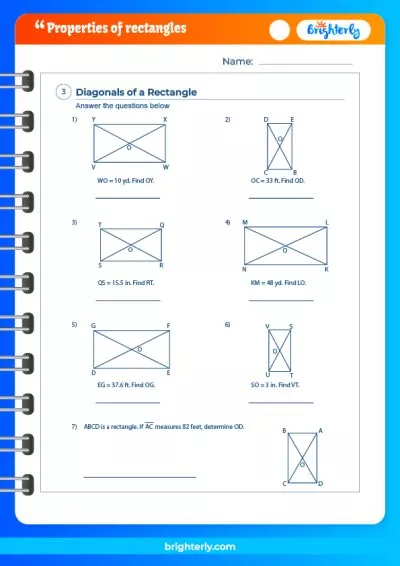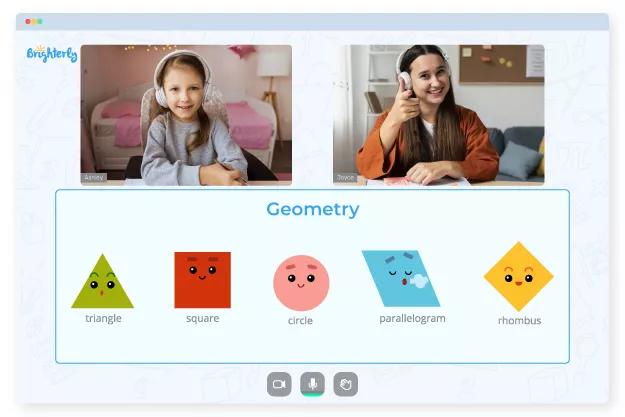Rhombus – Definition with Examples
Updated on January 13, 2024
A rhombus is an intriguing geometric form that appears in art, architecture, and the natural world, among other places. This article will teach us how to compute the area and perimeter of a rhombus as well as examine its characteristics. Additionally, we’ll provide you some practice questions to help you solidify your understanding of this adaptable structure. Now let’s explore the fascinating world of rhombuses and learn about their special qualities with Brighterly!
What is a Rhombus?
One kind of quadrilateral, or anything with four sides, is a rhombus. The equal length of each of a rhombus’s four sides is what distinguishes it. It is sometimes referred to as an equal quadrilateral. The square is another equilateral quadrilateral that you might be familiar with. Not all rhombuses are squares, even if all squares are rhombuses. Other characteristics of a square, such as all angles being equal, are not always true of a rhombus.
What Does a Rhombus Look Like?
A rhombus resembles a diamond or an oblique square. Imagine taking a square and pushing one set of opposite corners towards each other, causing the square to slant. As a result, the rhombus will have two sets of parallel sides. Visit Brighterly’s Worksheets to learn more about rhombuses and other quadrilaterals.
Properties of a Rhombus
There are several important properties of a rhombus that distinguish it from other quadrilaterals:
- All sides are equal in length: This is the defining characteristic of a rhombus.
- Opposite sides are parallel: This means that if you were to extend the sides indefinitely, they would never intersect.
- Opposite angles are equal: The angles formed by two adjacent sides are called the interior angles of the rhombus. In a rhombus, the angles across from each other will have the same measure.
- Diagonals bisect each other at right angles: The diagonals are the lines connecting opposite vertices (corners) of the rhombus. In a rhombus, the diagonals will intersect at a 90-degree angle and divide each other into two equal parts.
The rhombus plays a significant role in the curriculum of math for children, and Brighterly has some of the most interactive and enjoyable worksheets to help kids learn about this essential concept.
Area of a Rhombus
To calculate the area of a rhombus, we need to know the lengths of its diagonals. The formula for finding the area is:
Area = (diagonal1 × diagonal2) / 2
To calculate the area, simply multiply the lengths of the two diagonals and divide the result by 2. You can practice calculating the area of a rhombus using Brighterly’s Rhombus Area Calculator.
Perimeter of Rhombus
Calculating the perimeter of a rhombus is quite simple. Since all the sides are equal in length, you can multiply the length of one side by 4:
Perimeter = side × 4
Practice Questions on Rhombus
- Identify a rhombus in a group of quadrilaterals.
- Calculate the area of a rhombus with diagonals of 12 cm and 16 cm.
- Find the perimeter of a rhombus with a side length of 5 cm.
Conclusion
A rhombus is a fascinating and versatile shape that can be found in many aspects of our daily lives. By understanding its properties and learning how to calculate its area and perimeter, you’ll have a deeper appreciation for this unique quadrilateral. We hope this article has helped you gain a better understanding of rhombuses, their properties, and how to work with them in various mathematical problems. Remember to practice your new skills and reinforce your understanding through exercises and real-world applications.
Frequently Asked Questions
Is a square a rhombus?
Yes, a square is a special type of rhombus. All squares are rhombuses because they have all four sides equal in length. However, not all rhombuses are squares, as squares have additional properties such as all angles being equal (90 degrees).
How is a rhombus different from a parallelogram?
Both rhombuses and parallelograms have opposite sides parallel, but a rhombus has all four sides equal in length, while a parallelogram only requires that opposite sides are equal in length.
Can a rhombus have right angles?
Yes, a rhombus can have right angles. In fact, if a rhombus has all its angles equal to 90 degrees, it is a square.
How do you find the side length of a rhombus if you know the diagonals?
If you know the diagonals of a rhombus, you can use the Pythagorean theorem to find the side length. Since the diagonals of a rhombus bisect each other at right angles, they form four congruent right triangles. Using half the length of each diagonal as the legs of the right triangle, you can find the side length (the hypotenuse) using the formula:
Side length = √((diagonal1/2)^2 + (diagonal2/2)^2)






